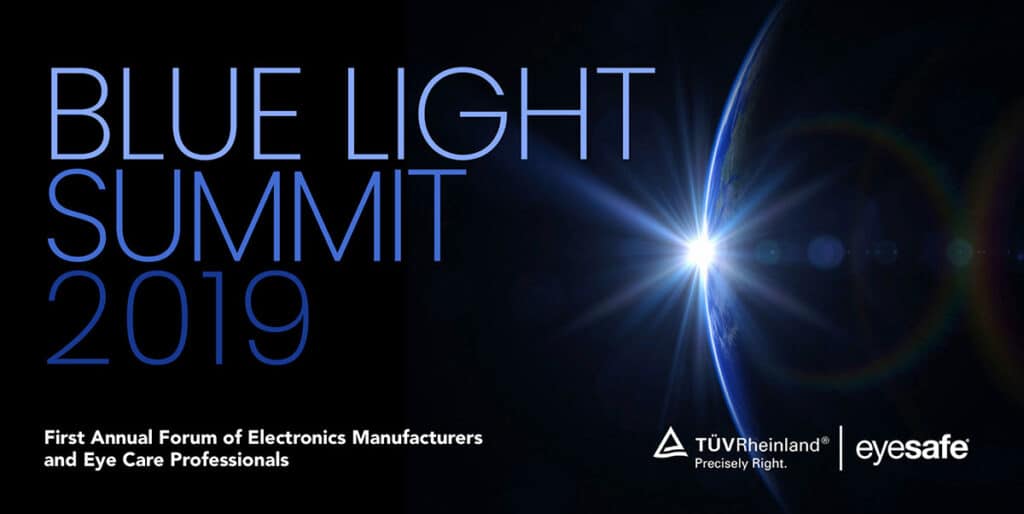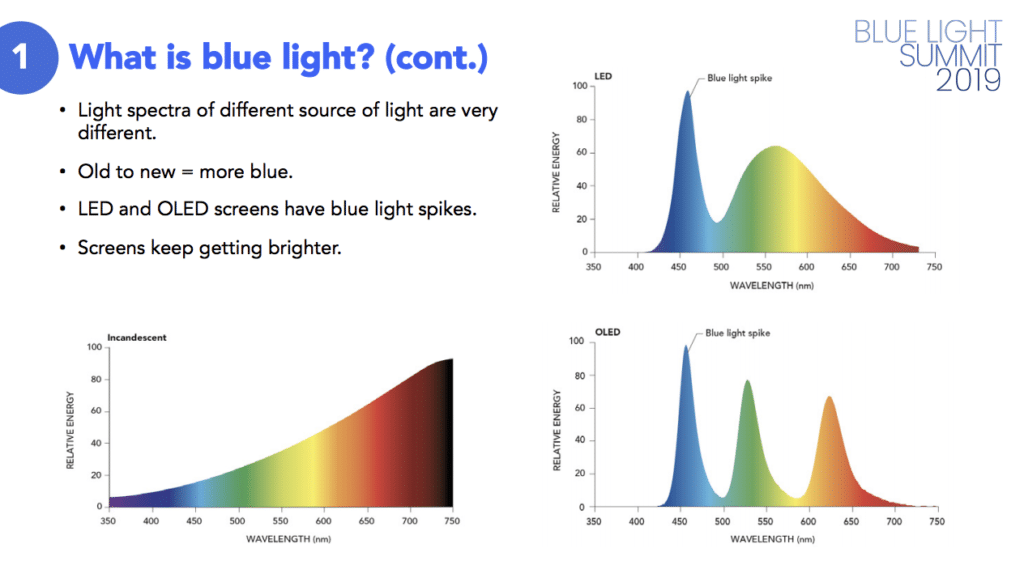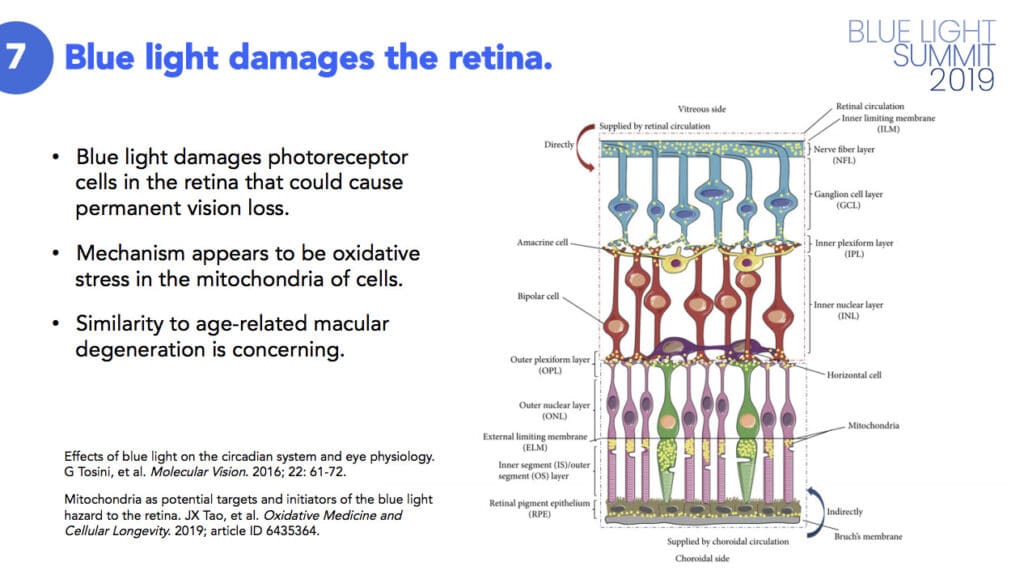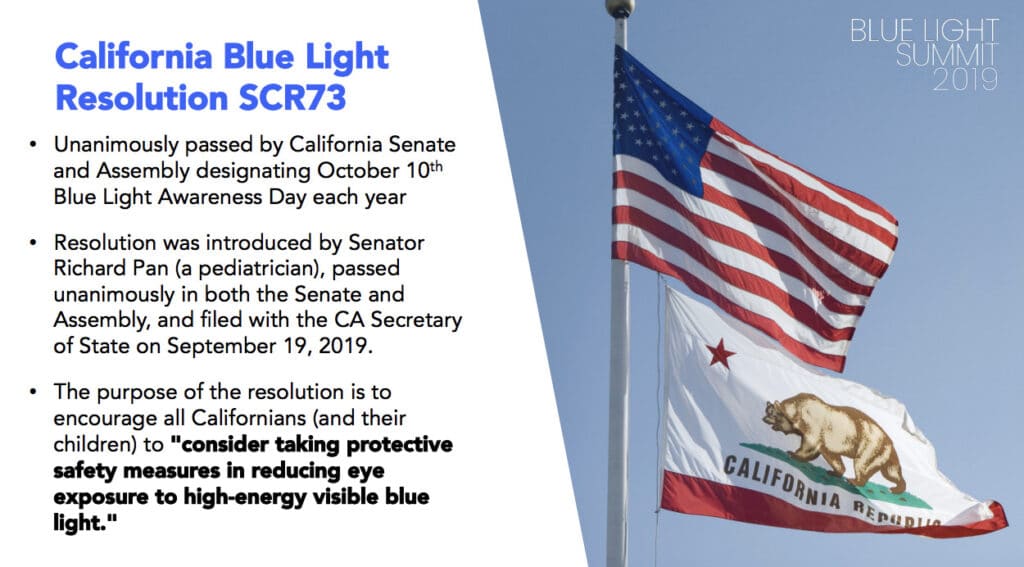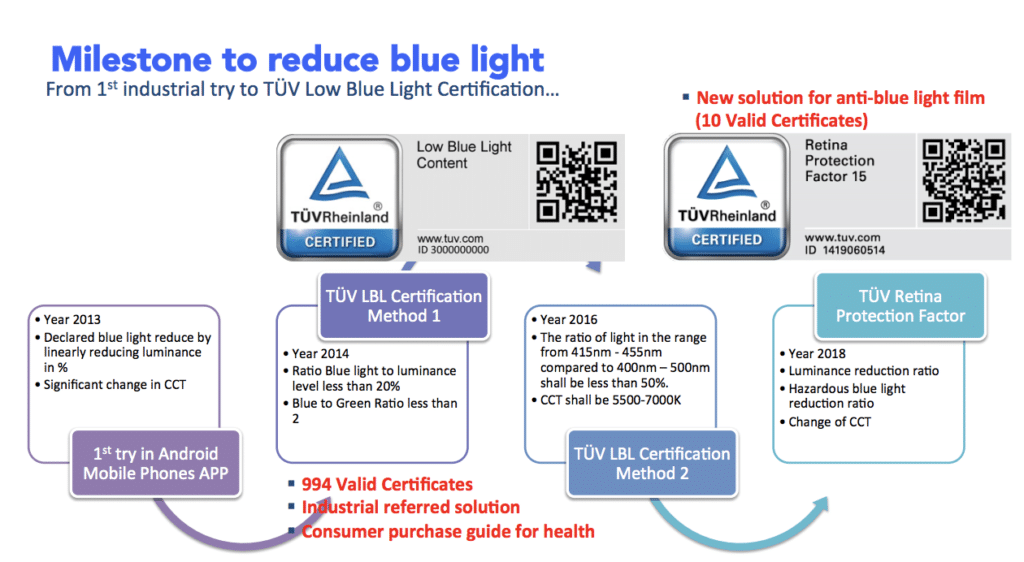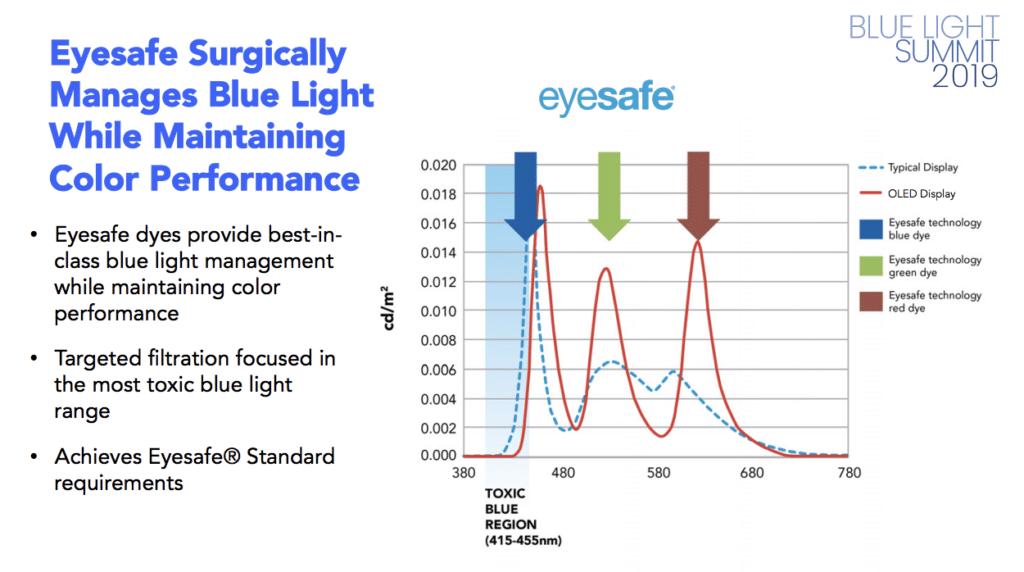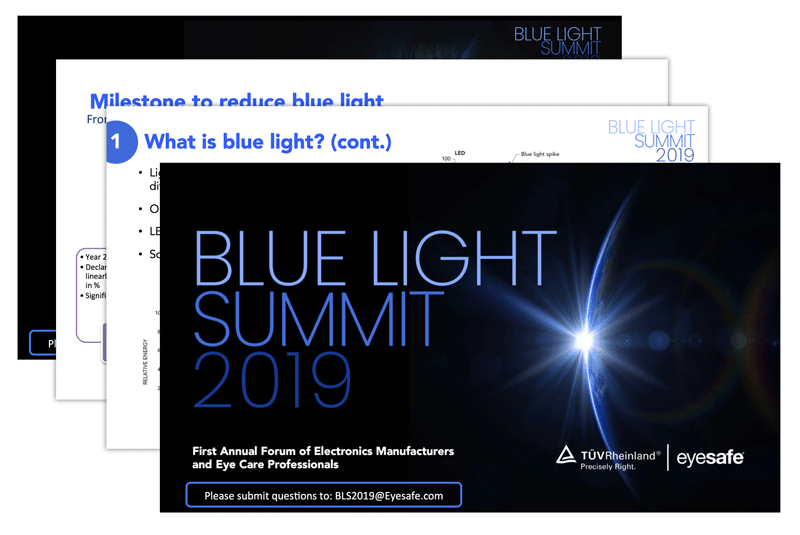Blue Light Summit 2019 Transcript
8:00PM CT, Tuesday, October 29 | 9:00AM China Time, Wednesday, October 30
Welcome:
Justin Barrett – CEO, Eyesafe
Slide 1
Hello everyone, and welcome to the Blue Light Summit 2019 hosted by TUV Rheinland and Eyesafe. This is Justin Barrett, CEO of Eyesafe and we are excited to have you join today. This is a first of its kind event that brings together leaders in the eye care and consumer electronics industries to provide you valuable information and actionable next steps.
You will have questions that come up during the meeting today, and we’d like to encourage your participation and to submit questions to the email [email protected] and we will address them following the material review. During the presentation please remain muted, and we will address questions and discussion at the end.
Slide 2
The purpose of the Blue Light Summit is to annually bring together leaders in both health care and consumer electronics industries for the design, development and certification of healthier display products. This is why we have participating today device manufacturers that represent the majority of the world’s consumer electronics and renowned thought leaders in eye care.
Slide 3
Today we have representatives from over 40 major consumer electronics manufacturers and suppliers; together with the Vision Health Advisory Board, a group of leading optometrists and ophthalmologists; and we are now live streaming to representatives from 14 different countries across multiple time zones.
Slide 4
The material that we will review today, including the research and standards, have been guided by the Vision Health Advisory Board. This is a group of world-wide recognized eye doctors that are dedicated to understanding the health issue of blue light and developing standards to guide the display industry. This includes consumer issues and commercial display applications. If you have a question for the Vision Health Advisory Board, please email [email protected]
Now, we will welcome Jay Yang, TUV Rheinland Group Vice President to share more.
Jay Yang – TUV Rheinland, Group Vice President
Hello everyone, I am Jay Yang from TUV Rheinland. We welcome you to join in the first annual Blue Light Summit. TUV Rheinland is a 147-year-old, third-party testing company; we are dedicated to improving the display product blue light management for many years. We have developed low blue light certification since 2014 and since then our certification has been branded to support six major product categories recently.
Based on the deeper interaction with display-relevant industries, as well as eye care organizations, we realized that the blue light management in consumer electronics becomes more and more important and the communications within a bigger group of our stakeholders becomes a must. While in 2018, we established a partnership with Eyesafe to better drive the anti-blue light technology and certification. We are glad to host this annual meeting together with Eyesafe and we hope we can bring valuable information to you all and can benefit the whole display industry.
Slide 7
Thank you, Kalyan and TUV Rheinland for your collaboration on the Blue Light Summit. As screen time and blue light exposure continues to increase, there exists a need to advance and understand the research, develop guiding standards which are based in human health, and develop healthier display products. That’s the purpose of Eyesafe. As you’ll hear more about this today from our team, Eyesafe works with world leading researchers and doctors, standards organizations, insurance providers, and display manufacturers to offer healthier display solutions for the digital age. We are excited to be collaborating with many of you on the line today and TUV Rheinland on this important work and have exciting announcements to share with you today.
Slide 8
For agenda, we will cover five primary topics today we think you’ll find valuable- starting with a summary of blue light health issues, an update on regulatory and insurance initiatives, we’ll provide a review of standards and certification, solutions and leave time for question and answer. Just a reminder once again that as questions come up, please email them to the [email protected] email.
Now we’ll take it over to Dr. Gary Heiting for a review of blue light health effects.
Gary
Slide 9
Thank you, Justin. I’m Gary Heiting, an optometrist and Director of Vision Research at Eyesafe.
Thank you all for participating in this important webinar.
I’d like to take a few minutes to discuss what some of the more recent research is telling us about the known and potential health effects of blue light.
Let me start by saying the effect of blue light on the eyes and our general health has generated a lot of interest in the research community recently – which is good.
But because this interest has developed relatively recently, there’s still much we don’t know about the health effects of blue light.
Also, it’s going to take time before we have data from long-term clinical trials and population studies to give us a fuller understanding of all the effects of blue light on our eyes, vision, minds and bodies.
But one thing is already certain: There’s significant concern among many eye care and medical professionals and medical that the amount of time people – particularly children – are spending in front of the blue light-emitting screens of electronic devices may be causing serious health problems that we’re not yet fully aware of.
Let’s take a look at blue light and its health effects…
Slide 10 – What is blue light? (slide 1 of 2)
First, a quick overview about visible light and high-energy visible blue light…
Visible light is electromagnetic radiation that can be perceived by the human eye and ranges in wavelengths from roughly 400 to 700 nm.
Blue light makes up about a third of the visible light spectrum, ranging in wavelengths from 400 to 500 nm, and it’s the type of visible light that has the highest energy.
The portion of the blue light spectrum that we call toxic blue light – also called harmful blue light or high-energy visible blue light – which ranges in wavelength from 415-455 nm – is closer to UV radiation in the amount of energy it carries, compared with the amount of energy carried by much of the remainder of the visible light spectrum.
We call this 415-455 nm range of blue light TOXIC because this is the portion of the blue light spectrum that appears to be the most damaging to tissues in the eye – specifically the retina.
The primary source of blue light is sunlight. But blue light is also emitted by the screens of electronic devices. And this incremental blue light exposure is becoming more and more significant as people are spending more and more time on their devices.
For this reason, today’s generations of young people will be exposed to significantly more blue light in their lifetimes than people in previous generations.
And research suggests there may be significant risk of health effects associated with this added blue light exposure from devices.
Slide 11 – What is blue light? (cont.)
This slide shows that different light sources have a significantly different output of blue light, including harmful blue light.
Incandescent lighting of the past emitted very little blue light. But modern LED light and displays and even OLED displays have a significant spike of blue light emissions, increasing our exposure to this high-energy visible light.
Slide 12 – Not all blue light is equal.
This slide shows that, within the blue light portion of the visible spectrum, not all blue light is of equal concern when it comes to health effects.
This table, from the American National Standards Institute (ANSI) shows the effect of applying identified a blue light hazard weighting factor across the blue light spectrum.
You can see here that the 415 to 455 nm zone is the area of greatest toxicity concern when it comes to health effects on the eye, peaking at roughly 435-440 nm, since blue light of these wavelengths have been shown to cause damage to photoreceptor cells in the retina.
Slide 13 – Children are especially at risk.
Just as all blue light is not equal, so, too, all eyes are not equal when it comes to blue light exposure.
Specifically, the eyes of children are more susceptible to blue light effects. This is because the lens of a child’s eye is more transparent and less capable of filtering blue light than the lens of an adult eye.
It’s been estimated that 65% of blue light passes through the lens of a child’s eye to the retina.
And at the highest-energy end of the blue light spectrum – at 400 nm – a child’s retina is exposed to 10x more blue light of this wavelength than an adult’s retina because of this immature blue light-absorbing capacity of the lens.
Another important factor is that children tend to hold their devices closer to their eyes than adults do.
And because of the Inverse Square Law, if a child holds their device at half the distance an adult does – say at 12 inches (30 cm) from their eyes rather than 24 inches (60 cm) – this increases the irradiance by a factor of 4.
These factors – along with the long hours that children are spending on their devices from an early age on – are key reasons why children today will experience a significantly greater cumulative exposure to toxic blue light in their lifetimes, compared with previous generations.
Slide 14 – Blue light disrupts sleep.
Sleep plays a vital role in brain function and physiology across many body systems, and blue light exposure late in the day and before bedtime has been shown to disrupt normal sleep.
Sleep disruption has been shown to be associated with the development of a number of health problems – including high blood pressure, cardiovascular disease and more.
But another thing happens as well…
When people can’t fall sleep, they tend to pick up their devices again – which leads to even longer hours of daily blue light exposure time – and greater exposure to toxic blue light.
Slide 15 – Blue light is linked to digital eye strain.
Digital eye strain is a syndrome of several stress-related symptoms related to use of electronic devices, including eye strain, dry eyes, eye pain or discomfort, blurry vision and headaches.
We know the risk of digital eye strain increases with longer time spent looking at the screens of electronic devices – and that as many as 65% of people who view electronic display for much of their day experience symptoms of digital eye strain.
We don’t yet know the extent that blue light exposure contributes to these stress symptoms.
But it’s well-established that blue light scatters inside the eye to a significantly greater degree than visible light of longer wavelengths and less energy.
It’s likely that this increased light scatter may make it more difficult for the eye to accurately focus on objects on the screen and maintain accurate focus. This could contribute to focusing fatigue, which has been indicated as a significant factor in digital eye strain.
So, this is an area where more research is needed, but another possible health concern that blue light may play a role in.
And, because digital eye strain affects worker comfort and productivity, this could have significant implications in the workplace.
Slide 16 – Blue light causes dry eyes.
Two very recent studies – one in China and one in Japan – have found that blue light causes oxidative damage to cells on the surface of the cornea of the eye, resulting in inflammation and dry eye symptoms.
This is very significant because we now have evidence that blue light can have a direct effect on dry eye.
More studies will help confirm the role of blue light in dry eye syndrome, but the authors of the Japanese study were convinced enough by the findings of their research to say, “we recommend blue light protection to maintain ocular health, especially in high-risk populations, such as people with dry eye [and] contact lens users…”
Slide 17 – Blue light damages the retina.
This slide shows a cross-section of the human retina.
The retina is a complex neurological structure that converts light energy into impulses that are conveyed to the brain where the process of vision takes place.
Of particular importance is the macula, a tiny zone measuring only 5.5 mm in diameter in the center of the retina that is responsible for our detailed vision and color vision.
Damage to the retina is of great concern to eye care professionals because if a significant number of photoreceptor cells in the retina are damaged, they cannot be repaired, and permanent vision loss occurs.
This is what happens in age-related macular degeneration (AMD), which is a leading cause of permanent blindness globally, and especially in developed countries.
Several studies have shown that blue light can damage photoreceptor cells in retinal tissue.
Though much more research is needed to determine energy thresholds for this damage and other factors, it appears there’s a real risk to the retina from blue light exposure, and similarities in the mechanism behind this damage to mechanisms involved in the development of AMD are very concerning.
Slide 18 – Blue light has psychological effects.
The prevalence of depression in adolescents and young adults in the U.S. has increased significantly in recent years – during the same period of time when use of electronic devices by children also has increased.
Though much more research is needed to determine if an association exists and what role blue light may play in this, some health care providers are concerned there might be a connection between about these concurrent trends.
Slide 19 – Blue light impairs cognitive performance.
A recent study of night-shift operators at a medical emergency operations center in Iran found that adding a blue light-filtering software to their PCs improved the users’ cognitive performance at work and sleep quality at home.
This was a relatively small study and additional research is needed, but it appears that reducing blue light exposure may have significant impacts on worker productivity.
Slide 20 – Blue light accelerates aging.
Recent studies also have demonstrated that blue light exposure may play a role in aging and longevity.
One of these studies found that fruit flies maintained in daily cycles of 12-h blue LED and 12-h darkness had significantly reduced longevity compared with flies maintained in constant darkness or in white light with blue wavelengths blocked.
Other studies have found a connection between blue light exposure and aging changes in the skin.
Slide 21: Blue Light Health Effects Summary
• Sleep Disruption (and assoc. health problems)
• Digital Eye Strain
• Dry Eyes
• Retinal Damage
• Mood Disorders & Psychological Effects
• Reduced Cognitive Performance
• Accelerated Aging
Slide 22: (Handbook slide)
I hope you found this very brief summary of the health effects of blue light helpful.
These potential effects are why we at Eyesafe are passionate about helping the electronics industry bring products to market that limit blue light to keep device users safe and healthy.
For more information about this topic and more, all attendees of this webinar can receive a free copy of the first edition of the newly published, Blue Light Handbook for the Electronics Industry and Eye Care Professionals, How to Save your Eyes in the Digital Age, by sending a request to [email protected].
I’d now like to introduce you to Dr. Alya Pender, one of our research rcientists at Eyesafe, who will discuss some of the key research about the health effects of blue light.
Alya
Slide 23
Thank you, Dr Heiting,
Hello everyone, I am Alya Pender, Research Scientist at Eyesafe and I am going to say a few words about Eyesafe’s guiding research
As mentioned before, the handbook holds key information from an extensive collection of scientific articles on blue light impact on health gathered by the Eyesafe team.
Among the scientific articles these 5 articles highlight key points:
• On LED and phototoxicity to the eye
• On the impact on circadian rhythm, eye strain
• On consideration of populations at risk such as children
If you would like to review these articles you can visit Eyesafe.com/research
At Eyesafe the research is constantly updated and lays the groundwork to the Eyesafe standards, which will be presented later.
But first I will let Dr. Friess, member of the Eyesafe’s Vision Health Advisory Board, talk about the California Resolution and the research with Salus University, a prominent optometry school in the United States.
David, Mitch Slides 25, 26
California Resolution and Market Initiatives – Dr. David Friess/Dr. Mitch Jackson (10 minutes)
• CA SCR73
• New Research/Salus Research Program
• Insurance/Eyemed Announcement
Slide 27: CA SCR73
On September 19, 2019, California State Senator Dr. Richard Pan, who is also a pediatrician, introduced California Resolution SCR73.
The California Blue Light Resolution passed unanimously by a vote of 70-0 in both the Senate and Assembly and was filed with the California Secretary of State.
This resolution designated October 10th of each year as Blue Light Awareness Day in the State of California.
The purpose of the resolution is to encourage all Californians and their children to “consider taking protective safety measures in reducing eye exposure to high-energy visible blue light.”
We consider this an important call to action, which consumer electronics manufacturers are responding to by incorporating blue light reduction methods across digital device product lines.
Slide 28: New Research/Salus Research Program
On October 10, 2019, Eyesafe and Salus University Pennsylvania College of Optometry in Philadelphia, Pennsylvania signed a Memorandum of Understanding (MOU) to partner in research projects about the health hazards and protective solutions related to blue light for the electronics display industry.
Salus is the premier optometry school in the country and is now celebrating over 100 years of leadership with 15,000 alumni.
The research will be led by Mitchell Scheiman, OD, PhD, FAAO, who is Dean of Research at Salus and has decades of experience in protocol development as a principal investigator on large-scale clinical trials.
Initial steps with this partnership include:
(1) Developing research protocols to evaluate the effects of blue light and blue light filtration with Eyesafe technology on dry eye and other signs and symptoms of computer eye strain, computer user productivity and comfort, gaming performance and eye health, including the effect of blue light on macular pigment density;
(2) Performing pilot studies at Salus University, the outcomes of which should be known within a six-to-nine month time frame;
(3) Work toward the long-term goal of having full-scale clinical trials.
Slide 29: Insurance/Eyemed Announcement
Eyesafe has been working to create large-scale partnerships that can bring blue light solutions to the public and address these health concerns.
The opportunity for health insurance providers to offer doctor-recommended blue light solutions to patients is an important aspect of connecting manufacturer solutions with more device users.
Today, Eyesafe is excited to announce that EyeMed, one of the largest vision health insurance providers, will begin offering Eyesafe-certified blue light solutions for digital devices across their network of 55 million members.
And now we will move to Paul Herro who will explain what this research and the Eyesafe standards mean for the display industry.
Mitch (Session 2 only)
(Note: Mitch Jackson MD is an ophthalmologist and member of the Eyesafe Vision Health Advisory Board.
We believe insurance solutions are important in the long-term related to reduced blue light solutions from consumer displays because of the health issues which we discussed. As a health provider, it’s of benefit to have patients exposed to less high-energy visible blue light.
We are actively working with insurance providers to integrate Eyesafe solutions as part of coverage, providing benefits to employers and members. This offers benefits and preferred pricing for large insurance membership groups, incentivizing the use of Eyesafe.
Today, we are excited to announce that EyeMed, the second largest vision insurance provider in the US, is integrating Eyesafe within coverage for its 55 million members. This is important not only for manufacturers, but for greater human health as well.
Paul Herro, COO
Slide 31, 32, 33, 34:
The Eyesafe standards were developed to enable device makers a vehicle that describes products in a health and safety light, while setting limits for blue light exposure and display color performance.
The Eyesafe standards allow for brand licensing and/or technology licensing to meet these targets, leading to device makers offering a high-performance display with low blue light emissions.
Device makers leveraging the Eyesafe brand get to take full advantage of all Eyesafe activities–including regulatory work, blue light advocacy, research and blue light education.
Ultimately, the Eyesafe standards enable companies to use the Eyesafe brand to differentiate products as high performance and addressing health and safety concerns. Essentially, electronics manufacturers can now promote a “health first” product with confidence.
I will now introduce my colleague Stanley Liu, from TÜV Rheinland to talk about standards and some special news.
Stanley Liu, TUV Rheinland
Slide 35
Hi Paul, I am Stanley Liu from the Tuv Rheinland Group and I’m leading the technical competence center at TUV Rheinland. Our mission is to drive the low blue light standard in the development and make sure consumers can buy the product that is certified by a third-party laboratory.
TUV Rheinland started looking into the blue light issue since 2013. At that time the display products widely used LED back light and there are many different software’s that can provide the blue light reduction function for the Android and smartphone and software, so we started looking into that issue since 2013 and we do a lot of research and we found many software that just reduce the luminance ratio but there are significance change to the color temperature and this impacts the user experience a lot.
Slide 36
So, after a lot of research, in 2014 we introduced the first TUV Rheinland low blue light certification. We call it Method 1. There are two different requirements. The first one is we define the ratio of blue light to the luminous level should be less that 20% and the blue to green ratio at the height of the peak should be less than 2. So, these two requirements were established very early on for the display products to regulate the blue light emission of your display products.
The manufacturers uniformly achieved this one by reducing the blue ratio of RGB color and then you can have ‘yellowish’ color of your screen, we call it the software solution adjustment to control the blue light. In 2016 we introduced low blue light certification Method 2, which has two requirements. The first one is the ratio of light in the range of 415 to 455 nanometers compared to 400 to 500 nanometers shall be less than 50%. That means the backlight spectrum of your display has this blue ratio. And the second requirement is the display color temperature is between 5500 and 7000 degrees Kelvin. This is Method 2 and the industry calls it the hardware solution because in order to pass this requirement you need to have the panel which has the shifted peak spectrum. You cannot simply achieve this one with the software adjustment. And so far, we have certified almost 1,000 product certificates in the TUV Rheinland database, and the local certification requirement is widely referred to in the industry and widely accepted by the consumers as a purchase guide.
Slide 37
And in 2018 we are very happy to have the partnership with Eyesafe as we introduce the joint certification the Retina Protection Factor 15, or 20 or 30. This is a new solution for the anti-blue light film and so far, we have certified more than ten products. Now it is widely used in the consumer markets, especially for the smartphones industry. Later, I can come back with detailed requirements about RPF15.
Slide 38
Based on the development in past years, now I think we are able to announce the new industry mark to represent health and safety for manufacturers. This is a balanced requirement about health and safety and represents the efficacy in protection from blue light and color quality. Before we were limited by technology development, we focused more to the blue light ratio of the display, but now since the fast development of new technologies we are able to balance blue light limitations and also higher color quality. We identified the achievements of Eyesafe standards and balanced the health requirements. As you can see, the Eyesafe display will be the certification system and you can put this case mark for your product if you meet the Eyesafe requirements.
This is the joint Eyesafe display certification program between Eyesafe and TUV Rheinland. We also did an Eyesafe validation service for manufacturers that can apply for the TUV Rheinland certificate and also get the Eyesafe mark or logo registered. So, TUV Rheinland developed this service, we will do the testing and issue the test report to the manufacturers and also to Eyesafe and then this process is based on the Eyesafe requirements. We need one sample for the complete testing and we also need to review the documents, the Eyesafe documents, as well as some declarations from the manufacturers. The lead time is 2 to 3 weeks.
And then, if everything passes, the manufacturers can get the TUV Rheinland – Eyesafe display certification as well as Eyesafe logo registered.
Slide 39
Also here is the Eyesafe certification process. The client will submit the Eyesafe license application first, to Eyesafe, because we have to use the Eyesafe technologies to achieve this requirement, and then Eyesafe will collect the data and submit the application to TUV Rheinland. We will serve as the independent review laboratory and review the documents and specifications and conduct the testing at the laboratory. If the product passes, then we will issue the test report to the manufacturers and also inform Eyesafe the product passes the requirements. Then Eyesafe can also approve and enroll the models in the Eyesafe license program. The process lasts from 3 to 4 weeks. In the future, we can do it faster. Please note the requirement, this is a joint certification that involves using the Eyesafe technologies to achieve the blue light reduction and maintain the good color performance. It requires a commercial agreement with Eyesafe and participation in the Eyesafe program. Only in this way are you allowed to use the Eyesafe logo on your product.
Slide 40
Here we come back with the TUV certification for accessory film. We call it the Retina Protection Factor, right now we have 3 classification requirements, RPF15, RPF20 and RPF30. We have three different requirements. The first one is RPF label, this is a B Lambda weighted blue light energy level and the second level is the luminance reduction because we don’t want to have the luminance reduced a lot because we want to filter the blue light. Last is the control of the color temperature change, as you can see in the market many blue light filtration films can reduce the blue light, but they can impact your color performance a lot. So, our RPF requirements need to have a good balance between the blue light reduction, the luminance reduction and also the change of color temperature. Currently the industry can achieve RPF15 and some manufacturers are working to RPF20 and RPF30. I believe in this year you will see some product for smartphone industry that achieve RPF30.
Slide 41
As you well know, we will have the second annual China International Import Expo in Shanghai from November 5 -10. We welcome you to join us because we have a joint event with Eyesafe to release the Blue Light Handbook during the event. We also welcome you to contact us to arrange a detailed technical meeting or certification meetings during this period. So, this is my part, and now let’s welcome Dr. Derek Harris to give a detailed introduction to Eyesafe technologies and Eyesafe solutions. Thank you.
Derek
Slide 42, 43
Hello Everyone,
I’m Derek Harris, the VP of R&D for Eyesafe. I’m happy to talk with you all today about some of the solutions for blue light filtering that we’ve developed at Eyesafe, which are an important partner to the research and standards.
Slide 44
This slide shows a couple of the different methods of blue light filtering. The graphs on this page shows the light emission for a typical LED back-lit display. In the left half of the screen you can see the emission curve for a display with a more standard type of blue light filter. The far-left shaded portion of that curve shows the more toxic portion of the blue-light. In the version of blue light filter used in most all software controls as well as some film or hardware filters the overall blue light is reduced. You can see the original peak of blue-light reduced wholesale in the second version of the spectrum (signified by the white line). This does of course reduce the overall blue light hazard but at the expense of color with a dramatic shift in the color temperature of the picture as well as skewing the overall color gamut. I’m sure you all are familiar with the color of the screen when certain controls are switched on for night time viewing of the screen.
Eyesafe takes a much more surgical approach to that filtration – you can see this in the right half of the slide. We have focused our filtration using patented technology on only the most toxic portions of blue light. This causes much less distortion of the color and preserves the color gamut.
Slide 45
This next slide shows the emission curves for typical LED back-lit displays (the dashed blue line) as well as a typical OLED display (with the red line). We also show that same filtration focused on the most toxic portion of the light emissions. In order to further improve the color gamut of the filtered display you’ll also see that there is additional filtration of the green and red portions of the emission curves. Again, this is to further improve the color balance of the display.
We have also designed our product so that both LED and OLED displays benefit from Eyesafe blue-light filtering. Through our survey of the most recent OLED products we have found that, while the ratio of toxic blue light to total blue light might be reduced the overall emission of toxic blue light is still high, and in some cases higher than standard LED products. This is due to the higher brightness of some OLED displays. Eyesafe® products can bring both of these products within the applicable certifications and standards outlined by Paul and Stanley earlier.
Slide 46
In this next slide, you see that we have developed products for both display and after-market screen protectors. We are designing these products so that they will pass the respective certifications that Stanley described earlier – both the Eyesafe display requirements and the TUV RPF certification.
Slide 47
Finally, we are developing Eyesafe® technology so it can be implemented in a number of different ways. In the graphic on the farthest left on this slide you see an LED and we are able to put our blue light filtering in to the LED package in a couple of different ways. We can also incorporate the Eyesafe® technology into coatings that can be applied to different layers within the display stack. Finally, we have also incorporated Eyesafe® technology into adhesive layers that can be used in screen protectors or within the display stack itself.
Thank you very much and please if you have any questions send them to [email protected]
Slide 48
Slide 49
For next steps, if we haven’t yet addressed your question we will work to reply. If you have additional questions for the Vision Health Advisory Board, or would like to receive and English or Chinese version of the Handbook, please send an email to [email protected]. If you have questions on standards, certification process, product branding or technology solutions you can direct them to TUV or Eyesafe.
A copy of today’s presentation will also be available at BlueLightSummit.com for download.
Thank you for attending, taking time today, and we look forward to assisting you with blue light solutions and reviewing further with you.
